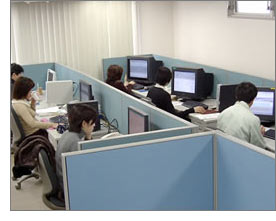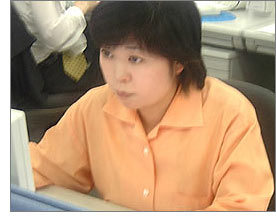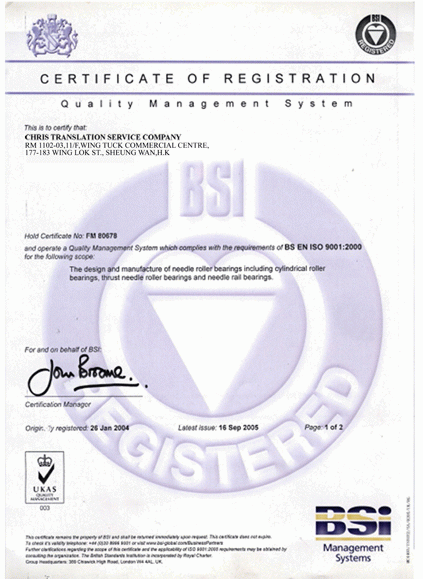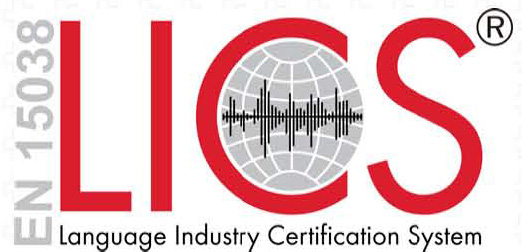 |
 |
|
 |
Translation Quality (Quality Control
(Localization)) of Chris Translation
|
| Based on past experience in localization
and rigorous quality control processes, Chris Translation Service Co responds flexibly and reliably to all
sorts of projects. |
Chris Translation has introduced rigorous quality control processes based
on past experience in localization in order to respond flexibly and reliably to all sorts
of projects.
The most important part in localization is the management of localization processes and
quality. In Chris Translation, a project manager makes detailed plans for localization
processes and quality control so that any changes in a project can be flawlessly handled.
This is accomplished by good quality staff including in-house translators, editors,
proofreaders, and engineers.
Translation is brainwork that requires a high degree of intellectual ability. This ability
can be taken full advantage of by making effective use of different types of information
provided by customers with TRADOS or other translation memory tools. A language leader
also plays an important role in producing uniform, high quality translations by leading
translators and editors.
This well-organized cooperation brings translators and checkers together to produce
quality translations. A project manager with excellent communication skills and staff
management ability who is familiar with localization controls these processes and project
members. |
 |
Process
& Quality Control System |

| Before assigning files to translators, they are analyzed and grouped, tables of
contents, indexes, and predefined expressions are translated, as appropriate, and build
tests are conducted. |
| Translators translate documents according to style guides and terms lists provided by
customers, if any. Translators use TRADOS, ForeignDesk, or other translation support tools
as requested by customers, and translate in collaboration with each other over a LAN on
site. (Forming a project team for shared use of a translation memory (TM) improves
translation quality and consistency.) |
| In a language review, translations are compared against original sentences to check
for incorrect translations or omissions. In this process, according to rules of technical
writing, translations are rewritten to make them easier to read and understand. |
| Proofreaders review translations against style guides and terms lists, if any, to
ensure that they are in the correct formats, the guides or terms lists are followed, and
correct expressions are used. |
|
 |
| System engineers with product knowledge review translations to check for technically
incorrect descriptions. |
| Staff responsible for QA extract 10% to 20% of translations reviewed in the previous
processes and test the quality of the extract. They also keep track of and analyze the
quality of original translations and reviewed translations and take measures to improve
translation quality if a problem requires such measures. |
| n 6. Embedding UIs
and checking the results |
 |
 |
 |
| Translations of user interfaces are embedded (compiled). |
| Staff responsible for QA extract 10% to 20% of the results of DTP and check that UIs,
figures, and tables are expressed and embedded correctly. They also check that a table of
contents and indexes are expressed correctly in the target language. They keep track of
and analyze translation quality after post-processing and take measures to improve
translation quality if a problem requires such measures. |
| Engineers build packages according to the system environments specified by customers.
The process here includes conversion into HTML and screen capturing. |
| Project members check operation consistency according to the customer's request. |
| Project members check test items in test matrices provided by customers. |
| Staff responsible for QA extract 10% to 20% of the results of DTP and check that UIs,
figures, and tables are expressed and embedded correctly. They also check that a table of
contents and indexes are expressed correctly in the target language. They keep track of
and analyze translation quality after post-processing and take measures to improve
translation quality if a problem requires such measures. |
| 1. |
QA staff extract 10% to 20% of the results of DTP and examine the extract in terms of
the following:
• Correctness of translation
• Appropriateness of language
• Consistency with products
• Appropriateness of styles and terms |
| 2. |
QA staff score -0.5 points for each error found. For any test item where the average
score is -1 point or below, a 100% inspection is conducted and appropriate modifications
are made for the detected items. |
| 3. |
Implementation method
A QA check is conducted for each lot, which consists of 50 files. QA staff extract 10% to
20% of 50 files or 5 to 10 files and check them according to check sheets. If 2 or more
areas to be modified are found in a single file, they conduct a 100% inspection and make
appropriate modifications for the entire lot. |
| After checks by customers, we deliver translations that reflect customers' requests
for modification, if any. |
|
 |
 |







